Brianna Caplan Sayres's Blog, page 3
June 11, 2013
Good News Day Tuesday: Interview with Three Authors Who Are in Highlights this Month!
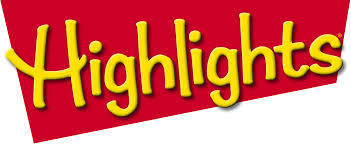 Happy Good News Day Tuesday! After my post yesterday about how wonderful magazines are for beginning readers, I'm so excited to be celebrating with three (yes, three!) authors who are all published this month in magazines published by the Highlights magazine family. Highlights is amazing and these authors are amazing too!
Happy Good News Day Tuesday! After my post yesterday about how wonderful magazines are for beginning readers, I'm so excited to be celebrating with three (yes, three!) authors who are all published this month in magazines published by the Highlights magazine family. Highlights is amazing and these authors are amazing too!Hope you enjoy this interview with Jeanne Kaufman (JK), Jody Jensen Shaffer (JJS),and Deborah Holt Williams (DHW)! I'm so excited to be celebrating their good news today. Please enjoy the insights they give into writing for children's magazines!:
First of all can you tell us the title and genre of your piece? What Highlights magazine and month is it (or will it) be published in?
JK: My poem, Ten Pins, is in the June 2013 issue of Highlights. It's a concrete poem, which means it takes the shape of its topic. In this case, the topic is bowling.
JJS: "Robins' Treat" is a poem for 0-2 year-olds. It was published in Hello in the June 2013 issue.
DHW: The name of my action rhyme is Body Language and it appeared in the June 2013 issue of High Five.
Where did you get the idea for this piece? Can you describe your process in writing it?
JK: I originally wrote this poem to submit to a sports anthology. That didn't work out and I thought it would be great for Highlights. This was one of those very rare pieces that came to me nearly fully formed. Of course, I needed to tweak it, but the idea of a bowling poem in the shape of ten pins was there from the beginning as was the last line, "gutter ball."
JJS: I love to watch the birds in my backyard. I am particularly amused by the robins that hop, hop, hop, stop, and then cock their heads to the side to watch the soil move, which indicates a worm below.
When I wrote, I tried to describe what I saw, using fun, kid-friendly language. For the last line, I wanted to add a touch of humor. I think it took a couple of revisions to get this poem finished.
DHW: I've worked with 3-5 yr-olds for years, as a preschool teacher and library Storylady, and now as a Spellbinders storyteller, and I love to get them up and stretching between stories. So this one and the two other action rhymes I've sold to High Five (Five Little Snowmen and Garden Stretch) came out of the need for a little movement during circle time.
What other published works of yours should we be on the lookout for?
JK: My first picture book, Young Henry and the Dragon, was published by Shenanigan Books in 2011 and was a finalist for the 2012 Colorado Book Awards. It's a rhyming story about a squire who has to trick a disagreeable dragon out of a little fire. Young Henry and the Dragon is available at Shenanigan Books, on Amazon, and at many local bookstores. It's also a title in the Reading Rainbow App. LeVar Burton reads it! That's a real thrill. In addition, I've had other poems and short fiction published in Highlights, High Five, Turtle, and The School Magazine of Australia.
JJS: I've sold more poems and nonfiction pieces to the Highlights magazines, Babybug has purchased a couple of poems, and I've got a couple of nonfiction books coming out in 2013. My first trade picture book will be out in 2014.
DHW: I have a 400 word poem about dragons coming out in the fantasy e-mag Spellbound this summer, a rebus in the September Highlights, and a poem in Hello, the new Highlights baby magazine, later this year. Highlights also bought a holiday craft piece, but I don't know when it will appear.
What do you see as the unique benefits and challenges of writing for magazines?
JK: I love writing for magazines. It's so great for those of us creating poetry for children to have these markets. The challenges are very similar to writing longer fiction. You need to know your audience and try to find a good fit and it's very competitive. But it's also very rewarding, especially seeing my work published in a magazine I read when I was a kid.
JJS: I love writing for magazines! The benefits are that my writing is seen by lots of children, the turnaround time between submission and publication is usually fairly quick, and there are lots of great kids' markets (and editors). The challenges are that if you target a submission to a particular magazine and that magazine doesn't pick up your piece, your may not have many other options. One way to take advantage of the work you've already done is to revise what you've written and send it out again to another market.I love writing for magazines! The benefits are that my writing is seen by lots of children, the turnaround time between submission and publication is usually fairly quick, and there are lots of great kids' markets (and editors). The challenges are that if you target a submission to a particular magazine and that magazine doesn't pick up your piece, your may not have many other options. One way to take advantage of the work you've already done is to revise what you've written and send it out again to another market.
DHW: If your motivation is to share your writing with lots of children, magazines are the way to go! According to Lou Waryncia, head of the AppleSeeds magazine group, the average book sells 5,000 copies, but Highlights has an audience of two million! The response time is generally quicker than it is from book publishers. The pay isn't fabulous, but the only investment required is a little paper and ink, an envelope and a stamp! I have found the editors at all the magazines I've written for, but especially the Highlights family, to be warm and encouraging.
How does this compare to any other kinds of writing you do?
JK: I see poems as puzzles. You have to fit the right words together in the right way. That's true for any kind of writing. It's just more intense when you only have four to eight lines to do it in (and when you have to come up with perfect, satisfying rhymes).
JJS: I also write trade picture books and nonfiction books for educational markets. Magazine writing is somewhat different from these other genres in the topics that are covered and the word counts of the pieces. Nonfiction writing also includes detailed writing specifications, like target reading levels. Magazine writing is similar to the other genres in that the ages I write for are all the same, roughly birth through early middle school, and many of the topics addressed by the books I write are the same as those addressed in magazine pieces.
DHW: Well, I've been successful in magazines, but so far have had no luck at all with picture books! I'd love to get one published one day. I'm doing 12x12, started by Julie Hedlund, that gives us the opportunity to pitch one manuscript a month to a real, working agent and get feedback, so I'm hopeful.
What advice would you give to new and aspiring writers?
JK: Read as much as you can. Read books and poetry and short stories. That will help you with your pacing and your tone. And read everything you can about publishing. There are some great books and websites out there that discuss the ins and outs of writing and publishing in the kids market. You can learn so much from the many generous writers who share their experiences. It also helps to find a critique group of partner. My road to publication would have been much, much more difficult without the sharp eyes and ears of my friends and critique partners in The Poets Garage.
JJS: Read the kinds of things you'd like to write (make sure you're reading things that have been published in the last 5 years, so you're up to date on current trends); draft, draft, and draft again; have a critique partner or group give you honest feedback; and don't be afraid to revise. Mostly, seek to improve and stick with it. You can't win if you don't play!
DHW: If you want to write for children, I think it's valuable to work with kids, and get to know their attention span, what makes them laugh, what bores them, etc. Being Storylady was great training, because I read hundreds of books and got to know the work of different authors, and what they did that worked or what didn't. Also, join SCBWI, find a critique group, and attend conferences and workshops if you can. I had already sold a couple things to High Five before I attended Chautauqua in 2011, but meeting the editors and some great authors (including my hero, Joy Cowley) was very beneficial sown the road.
Congratulations Jeanne, Jody and Deborah! Thanks so much for sharing!
So, have you tried writing for magazines? How does it compare to other writing you do?
Published on June 11, 2013 09:03
June 10, 2013
Keep Reading Fun Day: Why Magazines are Fantastic for Young Readers!
Yay! It's Monday, or, as I like to call it, "Keep Reading Fun Day"! And today I'm so excited to talk about something that is super helpful for young readers... magazines!
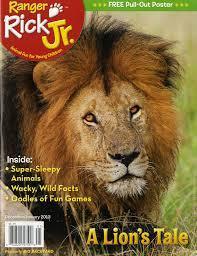 Around here, we love our subscriptions to Ranger Rick Jr. and Highlights High Five! And before Ranger Rick Jr,. we loved getting Your Big Backyard and Wild Animal Baby!
Around here, we love our subscriptions to Ranger Rick Jr. and Highlights High Five! And before Ranger Rick Jr,. we loved getting Your Big Backyard and Wild Animal Baby!And, of course, there are so many other wonderful kids magazines I look forward to subscribing to as my boys get older. (So looking forward to Cobblestone and Cricket and Highlights and Dig!)
Yes, kids magazines are awesome and they help keep reading fun in soooo many ways. Here are just a few of them:
2. When a child starts getting a magazine regularly, s/he starts to anticipate the regular features. "Let's read about Bonnie and Chester!" my son tells me. And of course we must read about Ricky Raccoon and his Friends. (We're big fans of Ricky's amazing illustrator Christian Slade around here because he also illustrated my picture book, "Where Do Diggers Sleep at Night?" :o) ) These regular features definitely help make reading fun!
3. Magazines provide fun reading variety. With short stories and poems, articles and activities, they feel different than books. And different can be good. Variety can really help to spice things up for a young reader. Some days we read just a poem or an article or a favorite story. Other days we read the whole magazine cover to cover.
4. For a beginning reader or for a reluctant reader magazine articles and short stories can provide super-fun and super-interesting short reading material. In Highlights High Five "The Adventures of Spot" and other wonderful stories provide such a motivating story for beginning readers each month.
And when I worked with older students one-on-one, I also loved magazines. There was so much learning to be done about how to read from a single article. The kids I worked with enjoyed the interesting reading material we found in magazines and so did I.
So what do you think about magazines? Which ones do the kids in your life like to read? What other benefits can they have for young readers?
p.s. Make sure to stop back here tomorrow to hear more about children's magazines. I'm going to be interviewing three Highlights published authors for Good News Day Tuesday! So excited to share their good news!
Published on June 10, 2013 07:23
June 4, 2013
Good News Tuesday: Interview with Lisa Kahn Schnell, a Debut Nonfiction Author
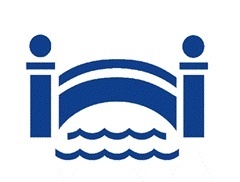 So excited to be celebrating Lisa Kahn Schnell,
So excited to be celebrating Lisa Kahn Schnell,who just signed a contract with Charlesbridge!
Happy Good News Day Tuesday! Today I'm so excited to celebrate with Lisa Kahn Schnell who just signed a contract for her first picture book! Congratulations, Lisa!
Lisa was kind enough to agree to do an interview where she shares wonderful information about her book, her writing process and the unique benefits and challenges of writing nonfiction for kids. (And some wonderful information about horseshoe crabs too! :o) )
Please enjoy Lisa's very thoughtful answers!
What can you tell us about your upcoming book?
My book will be about horseshoe crabs. The focus will be on the annual mass spawning event that takes place each year in Delaware Bay. In addition to all the horseshoe crabs that clamber onto shore, thousands of migrating shorebirds stop to eat the horseshoe crabs’ eggs. Scientists and volunteers come to study all these organisms--they are part of the story, too.
I hope the book will be a sort of invitation, that it will pique people’s curiosity and encourage them to come out and see these amazing animals. The book (title still to be determined!) is scheduled to be published in 2015, by Charlesbridge.
How did you get the idea to write about horseshoe crabs?
Despite having seen horseshoe crabs on the beach ever since I was a child, I didn’t know much about them. I started to read more and became fascinated by their story—not only have they been on this planet for hundreds of millions of years, but their tiny green eggs are critical to migrating shorebirds (who have their own amazing story!).
It turns out that horseshoe crabs are important to human health, too. I had been completely unaware that a product distilled from horseshoe blood is used to test pretty much all medical equipment, as well as vaccines and other medicines, to be sure they’re not contaminated with dangerous bacteria. This test using this product, called LAL (Limulus Amoebocyte Lysate), basically replaced the old-style tests on rabbits people used to do.
Horseshoe crabs are found all up and down the east coast of the US, and related species are found in Japan, China, India, and Indonesia, so it seemed like a book about them might appeal to a fairly large audience. It just all seemed like too good a story not to share. Plus, you know, I like the beach, and this gave me the perfect reason to go!
Can you describe your path to publication?
Long and twisty, and the book isn’t even out yet! Most recently, I attended the 2011 Highlights Bootcamp for Science Writers. I was especially inspired by one of the presenters, Loree Griffin Burns. She was—is—clearly having fun with her work! And, she helped me realize that writing about science could allow me to share that feeling of being out in the wild with a trusted expert, someone who shares what they love about the world in a way that makes me feel excited about it, too.
Once I had read a lot about horseshoe crabs and conducted interviews and even participated in some field research, I wrote and revised until I had a manuscript that was in reasonable shape. I attended the Falling Leaves Conference (SCBWI—E NY, in 2012), where I met editor Alyssa Pusey from Charlesbridge. Alyssa’s presentation at the conference made it clear that she cares about, and deeply understands, the challenges of writing non-fiction. After the conference, and after some more revising, I submitted my manuscript to Alyssa. Much to my delight, she accepted it!
What do you see as the unique challenges and benefits of writing nonfiction?
For me, the biggest challenge is to find a way to harness the energy that I feel when I’m out in the field, looking at some fascinating plant or creature, or talking to an expert, and to translate that energy onto the page. I want some kid in Chicago, who may never see a live horseshoe crab, to feel as excited about them as I do. I guess the other big challenge is leaving behind so much of the amazing information I uncover. Sadly, it just can’t all fit into one little picture book.
I think there are many benefits to writing non-fiction. I get to choose a subject that fascinates me, go to interesting places to learn more about that subject, talk with knowledgeable people to gather more details, and then I get to share what I’ve learned with children--and hopefully some adults, too. Seems like a pretty good gig to me!
What advice would you give to new and aspiring writers?
I am still a new and aspiring writer myself! Some things that have helped me so far, though—
I like to stick to a schedule. That means that I don’t answer the phone or schedule appointments in the morning, because that’s my work time. Even if I only work for half an hour, and even if no one else in the whole world cares if I do it, I need to show up for work.
I’m sure most aspiring writers have heard it before, but reading matters. The librarians at our local library tell me I’m great for their circulation numbers. I check out tons of non-fiction books, and that has helped me figure out what appeals to me in terms of form, presentation, and subject matter.
Also, it has taken some time, but I now have a network of other writers—local friends, online groups, in-person writing groups, people I’ve met at conferences. I can truly say that these people have kept me afloat during the bad times!
My dance teacher recently said something to me that I think applies to writing, too. She said, basically, “Stop concentrating on getting everything just right. Trust yourself. Show your joy!” And this comes from a woman who is quite a perfectionist.
I find it easy to get distracted by imagined (and sometimes real) rules about writing, or the new Common Core standards, or what’s current in the market, or whatever. But the writing I’ve produced that I consider to be most successful happens when I relax and trust myself. Doing that is not easy, and it’s not always under my control (in fact, it feels like it never is). When I manage to pull it off, though, I’m usually pleasantly surprised. So, if you love to dance, or write, or if you find some subject fascinating, let it show, and see what happens!
Lisa Kahn Schnell has worked in a prison, served as Peace Corps Volunteer, and started a school garden. She lives in eastern Pennsylvaniawith her husband, their two daughters, and a charming Ghanaian cat who stalks her ankles. (Only her ankles. Why?)
Congratulations, Lisa! Can't wait to read the book!
Have you considered writing nonfiction for kids? What benefits and/or challenges have you discovered?
Published on June 04, 2013 06:06
June 3, 2013
Keep Reading Fun Day: Why We Love the Library (and How I Figured Out How to Make Our Library Trips Awesome!)
Yay! It's another Monday/ "Keep Reading Fun Day"! And today I can't wait to write about one of the places in the world that does the most to keep reading fun... the library!
 One of the Seattle Public Library's
One of the Seattle Public Library'sawesome new options for library cards!Right now, I am lucky enough to live within a few blocks of the library I went to when I was a child. I remember how excited I was when I was old enough to sign up for my first library card. And I remember the book I checked out week after week. (How I loved "The Shy Little Girl"!)
Now I take my children to the library I used to go to as a five-year-old. It is a pleasure to see them get excited by the treasure trove of books they can check out there. What an incredible resource!
But, now that I am "Mommy," our trips to the library started to come with their own set of challenges.
And then there were the times I got myself I got myself organized enough to list some books we were hoping to find. Sometimes these times got even more frustrating. We were all excited to find those books, but, more often than not, they were already checked out. (My friend explained that our local library is one of the busiest in the whole system. Which is wonderful! Yay, Seattle readers! I just had to figure out how to get us the books we wanted.)
Finally I figured it out! And our library trips have been amazing ever since! The solution is probably obvious to you, but it took a while for this sleep deprived mommy to figure it out...
We started putting books on hold!
I know, I know. It's not rocket science but it has made a dramatic difference in our family. We are able to take advantage of the Seattle Public Library's awesome online resources.
Now, whenever we think of a title or an author or a category we're interested in, we head to the library's online catalog and do some pre-library-trip searching. This searching is so much fun as we have the entire city's library books at our disposal.
We get to think about which titles sound the most intriguing or the most helpful. And then we put them on hold. Often we get an email that these are ready for pick up quite quickly, but even when we have to wait a bit, we know we will be able to read the books we are waiting for soon.
It is such fun to go to the library and pick up an awesome stack of books (both print books and audio books) from the hold shelf. My oldest is always super-excited to make a trip to the library to pick up the books he has chosen.
And now that we have happily arrived at the library to pick up a whole pile of wonderful books, it is a pleasure do some relaxed browsing together and pick out several more books to add to the pile. My oldest with his sharp eyes always manages to spot an extra construction book or two. Or more books by a favorite author or from a favorite series. And my youngest loves to pick out fun board books from the library's collection for us to read together.
I even get to pick out some wonderful books for myself. Yay! (Super-important for me, the mom who as a young teen wanted to get my driver's licence so I could drive to the library. :o) )
Yep! Now our library trips are awesome! And they definitely help keep reading fun for our family!
So how do you use the library? What kind of library visits do you find works best with kids? How about when you're visiting the library on your own?
Published on June 03, 2013 06:01
May 27, 2013
Keep Reading Fun Day: Motivating Books are Key!
Once again it is Monday (or as like to I call it around here "Keep Reading Fun Day"). Last week, I wrote about the power of reading aloud and this week I am going to write about what I have found is key to come next, finding books that motivate young beginning readers to want to read.
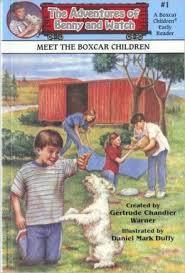 It can be very tempting to find the correct reading level for a child (a student or my own) and to give them a book at that level and expect them to start reading. At least I have made that mistake at times.
It can be very tempting to find the correct reading level for a child (a student or my own) and to give them a book at that level and expect them to start reading. At least I have made that mistake at times.About a year ago, my oldest son was ready to begin reading and I gave him books that were at the exact correct level for his current (very beginning) reading stage. Unfortunately, I had made a big strategic mistake. While some kids will read through books that don't interest them my son found this miserable. Part of it is probably personality and part of it is probably those wonderful read alouds. He had heard such wonderful stories that the very short books he was then able to read seemed very disappointing by comparison.
All I wanted was for my son to love reading and he professed to hate it. Ouch! What could I do? (I promise this story has a happy ending. Please keep reading :o) )
(While these books might not be great literature, they were motivating to my son. And, at that point, motivation was key!)
So we immediately went online to order a bunch of these books, and his passion to continue reading was reignited.
Recently, we had a similar issue. Thomas and Little Bear had lost their charm. But the Boxcar Children did the trick. He loves hearing these stories read aloud and now he is excited to be reading the easy reader versions of these books (which are not so easy) on his own.
It is a bit funny to me that I had to learn this lesson with my son. When I worked with reluctant readers in my private practice, the first thing I always did was find out what kind of books they liked to read. (Often their first answer was "short". :o) )
Once I got them to go beyond that initial "short" criteria and tell me more about what kinds of books could interest them, I would greet them the student the next week with a custom pile of books chosen just for them. And then I would empower them by asking them to divide their new books into three piles: -books they definitely wanted to read, books they might want to read and books they definitely did NOT want to read. I loved to see what an empowering experience making these piles was for my new students!
Yet, even though I've always known the power of motivating reading material, it is very easy to forget. Too easy to focus on level alone and to ignore a reader's interest (or lack thereof) in the book at hand.
I will work hard not to do this again!
So what books motivate the young readers in your life?
Published on May 27, 2013 09:37
May 26, 2013
And The Winner Is... (plus a pic from the book launch of THE EMERALD RING)
And the winner of a copy of WHERE DO DIGGERS SLEEP AT NIGHT? is Rachel Writes 4 Kids! Hope your nephew enjoys it Rachel!
Thanks so much to all for helping me to celebrate DIGGERS first birthday! (It seems like just yesterday she was a newborn. :o) )
This week I also had the pleasure of attending a wonderful book launch party for Dorine White's fantasy novel THE EMERALD RING.
Below is a picture of me Dorine and a very special attendee at the celebration. (At least he's very special to me!):
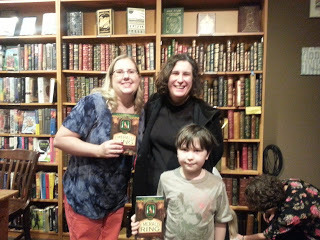
It was a pleasure to watch his face as he listened to Dorine read her book's exciting opening. Can't wait to read THE EMERALD RING together (once we are able to take a brief break from his beloved Boxcar Children)!
p.s. My comma key does not seem to be working. My apologies for any and all missing commas. :o)
Thanks so much to all for helping me to celebrate DIGGERS first birthday! (It seems like just yesterday she was a newborn. :o) )
This week I also had the pleasure of attending a wonderful book launch party for Dorine White's fantasy novel THE EMERALD RING.
Below is a picture of me Dorine and a very special attendee at the celebration. (At least he's very special to me!):

It was a pleasure to watch his face as he listened to Dorine read her book's exciting opening. Can't wait to read THE EMERALD RING together (once we are able to take a brief break from his beloved Boxcar Children)!
p.s. My comma key does not seem to be working. My apologies for any and all missing commas. :o)
Published on May 26, 2013 23:22
May 23, 2013
KidLitCares for Oklahoma
 Right now, we all want to do anything we can to help Oklahoma. And children's book author, Kate Messner has put together a special way for the kidlit community to help out.
Right now, we all want to do anything we can to help Oklahoma. And children's book author, Kate Messner has put together a special way for the kidlit community to help out.There's an opportunity to help the people of Oklahoma through a donation to American Red Cross Disaster Relief. And a chance to win one of many awesome children's books (including "Where Do Diggers Sleep at Night?").
Information about how to participate is included in the link below. And, if you're an author with a published book, you can email Kate and let her know you would like to donate a copy.
Here is the link to Kate's post:
http://www.katemessner.com/lets-help-kidlitcares-for-oklahoma/
Please participate if you can!
Published on May 23, 2013 06:59
May 22, 2013
WHERE DO DIGGERS SLEEP AT NIGHT? is Turning One! (A Book Giveaway!)
 Happy birthday to you! Happy birthday to you! Happy birthday dear DIGGERS! Happy birthday to you!
Happy birthday to you! Happy birthday to you! Happy birthday dear DIGGERS! Happy birthday to you!Yes, believe it or not, today is May 22nd and it is the first birthday of my debut picture book, WHERE DO DIGGERS SLEEP AT NIGHT?.
It has been quite a year for DIGGERS (and for me too)! She has been read by kids all over the country (and in many other countries too.) She has been read at loads of school visits and bookstore storytimes.She has helped me to do many, many truck slumber parties. And, she has become a bedtime favorite for many truck loving boys and girls.
To celebrate DIGGERS first birthday, I'm going to host a book giveaway. Entering is easy:
All comment posted before 11:59 (Pacific Daylight Time) on Wednesday 5/23 will be entered in a drawing. One winner will be chosen at random from all the names entered to receive an autographed copy of WHERE DO DIGGERS SLEEP AT NIGHT?.
Thanks so much for helping me celebrate! Hope you enter the giveaway!
Published on May 22, 2013 09:07
May 21, 2013
Good News Day Tuesday: Book Launch for The Emerald Ring by Dorine White (includes an author interview!)
Please note: This very happy new feature was scheduled far in advance of yesterday's tragedy. My heart goes out to those in Oklahoma. Sending love, thoughts and prayers...
***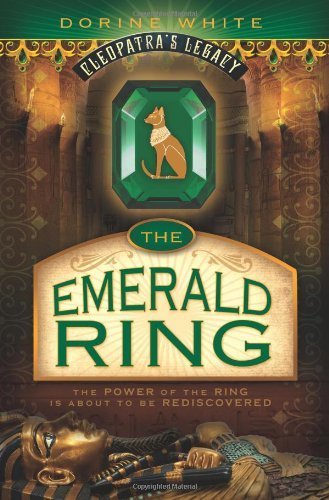 So I renamed Monday, "Keep Reading Fun Day", and now I'm renaming Tuesday, "Good News Day Tuesday". (Can you tell I write rhyming picture books? :o) ) Every Tuesday, I'm going to try to share some good news from around the kidlit community, so we can celebrate with our fellow authors and illustrators.
So I renamed Monday, "Keep Reading Fun Day", and now I'm renaming Tuesday, "Good News Day Tuesday". (Can you tell I write rhyming picture books? :o) ) Every Tuesday, I'm going to try to share some good news from around the kidlit community, so we can celebrate with our fellow authors and illustrators.
And today, we're going to celebrate with (drumroll please)....
Dorine White!
I had the pleasure of meeting Dorine at the amazing Western Washington SCBWI conference I attended recently, where she told me the exciting story of her upcoming debut novel, THE EMERALD RING.
Since tomorrow night (5/22) is Dorine's book launch (at Third Place Books in Lake Forest Park at 7:00), I thought her wonderful book news would make a perfect first bit of cheer.
So here's a brief interview with Dorine:
1. Please tell us about your book.
The Emerald Ring is a fantasy novel for ages 8 and up. The story goes like this, way back when, Cleopatra owned a necklace of magic gemstones. When she committed suicide, she entrusted her gems to a servant. They have been passed down through time, each with a different magic power. The catch, is that a murderous cult is after the gemstones, and will stop at nothing to get them.
Our story involves the emerald. Sara Bogus finds it in her Grandmother's attic. Presently it is a ring, which becomes stuck on Sara's finger. Sara quickly realizes that something is up when she starts having visions of ancient Egypt. Plus, she develops the ability to communicate with animals and shape shift into a cat. The problem is that a cult member is in town searching for the ring, and Sara must defeat him to keep her family safe.
2. How did you come up with the idea for your story?
I was inspired by two of my favorite things, Humanities and fantasy. I graduated with a degree in Humanities and love everything to do with culture. I also love fantasy books. My collection is huge. So, when I decided to write a book, I combined the two things I love.
3. Could you tell us about your path to publication?
My road to publication was long and bumpy. It has been almost nine years in the making. The Emerald Ring is my third manuscript, though I haven't yet sent out queries for number 2. I spent a year getting rejections from agents, and then a year and a half getting them from editors. Most had wonderful things to say, but it was never acquired. I had just given up, when I sent it out one more time. It was then that Cedar Fort bought it. Phew.
4. What advice would you give to aspiring writers?
Write what you love. If you are writing for trends or popularity, it won't go well. Readers know. Write what you read the most, what you dream about, and readers will feel that passion in your writing.
Yay, Dorine! Congratulations on your book launch for THE EMERALD RING!
***
 So I renamed Monday, "Keep Reading Fun Day", and now I'm renaming Tuesday, "Good News Day Tuesday". (Can you tell I write rhyming picture books? :o) ) Every Tuesday, I'm going to try to share some good news from around the kidlit community, so we can celebrate with our fellow authors and illustrators.
So I renamed Monday, "Keep Reading Fun Day", and now I'm renaming Tuesday, "Good News Day Tuesday". (Can you tell I write rhyming picture books? :o) ) Every Tuesday, I'm going to try to share some good news from around the kidlit community, so we can celebrate with our fellow authors and illustrators.And today, we're going to celebrate with (drumroll please)....
Dorine White!
I had the pleasure of meeting Dorine at the amazing Western Washington SCBWI conference I attended recently, where she told me the exciting story of her upcoming debut novel, THE EMERALD RING.
Since tomorrow night (5/22) is Dorine's book launch (at Third Place Books in Lake Forest Park at 7:00), I thought her wonderful book news would make a perfect first bit of cheer.
So here's a brief interview with Dorine:
1. Please tell us about your book.
The Emerald Ring is a fantasy novel for ages 8 and up. The story goes like this, way back when, Cleopatra owned a necklace of magic gemstones. When she committed suicide, she entrusted her gems to a servant. They have been passed down through time, each with a different magic power. The catch, is that a murderous cult is after the gemstones, and will stop at nothing to get them.
Our story involves the emerald. Sara Bogus finds it in her Grandmother's attic. Presently it is a ring, which becomes stuck on Sara's finger. Sara quickly realizes that something is up when she starts having visions of ancient Egypt. Plus, she develops the ability to communicate with animals and shape shift into a cat. The problem is that a cult member is in town searching for the ring, and Sara must defeat him to keep her family safe.
2. How did you come up with the idea for your story?
I was inspired by two of my favorite things, Humanities and fantasy. I graduated with a degree in Humanities and love everything to do with culture. I also love fantasy books. My collection is huge. So, when I decided to write a book, I combined the two things I love.
3. Could you tell us about your path to publication?
My road to publication was long and bumpy. It has been almost nine years in the making. The Emerald Ring is my third manuscript, though I haven't yet sent out queries for number 2. I spent a year getting rejections from agents, and then a year and a half getting them from editors. Most had wonderful things to say, but it was never acquired. I had just given up, when I sent it out one more time. It was then that Cedar Fort bought it. Phew.
4. What advice would you give to aspiring writers?
Write what you love. If you are writing for trends or popularity, it won't go well. Readers know. Write what you read the most, what you dream about, and readers will feel that passion in your writing.
Yay, Dorine! Congratulations on your book launch for THE EMERALD RING!
Published on May 21, 2013 05:29
May 20, 2013
Monday is "Keep Reading Fun Day" (and what my kids learn from read-alouds)
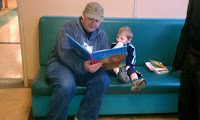 Father's Day read-aloud on the ferry!I write children's books, I read children's books and I love children's books. I also care deeply about helping kids to love reading them too.
Father's Day read-aloud on the ferry!I write children's books, I read children's books and I love children's books. I also care deeply about helping kids to love reading them too.Since helping kids love reading and books is something I care so much about, I have decided to rename Monday on my blog. Instead of Monday, it is now "Keep Reading Fun Day," and every Monday, I will post about something I'm trying to do to keep reading fun for kids.
Especially as Mommy to a learning-to-read 6-year-old, these tips are super important for me to remember. I want my son learn how to read. But I also want him to love reading once he has learned how. (And the same for my 4-year-old, once he is ready.)
So, for today's first "Keep Reading Fun Day", I will focus on the power of Read-Aloud!
1. They learn that reading is FUN!
Both boys will ask for book after book (or chapter after chapter), loving this special time together reading their (current) favorite books.
2. They learn loads of new VOCABULARY.
My 6-year-old is always asking "What does that mean?" and expanding his vocabulary accordingly. And my 4-year-old, who since birth has been loaded with a ton of diagnoses I wish I couldn't pronounce, knows the word "eiderdown" because of Mem Fox's beautiful picture book, TEN LITTLE FINGERS AND TEN LITTLE TOES.
3. They learn that they WANT to learn to read!
Trelease so wonderfully describes reading aloud as a powerful advertisement for reading. This advertisement is definitely working as a motivator for my oldest. Right now he adores it when we read aloud "Boxcar Children" mysteries to him (we are going through several a week ), and he is willing to do the challenging work of learning to read, so that he will be able to read them on his own some day.
4. They learn that they are part of a COOL CLUB filled with wonderful inside jokes.
When my 6-year-old was at a birthday party recently, somebody mentioned "vermicious knids". His ears perked up and he gave me a big smile. Other people at the party loved CHARLIE AND THE GREAT GLASS ELEVATOR too!
These are just a few of the benefits I've noticed with my own boys. Reading aloud to my students when I was a classroom teacher was always a highlight of our school day and had loads of similar benefits!
***So, what benefits do you notice when you read aloud to kids?
Published on May 20, 2013 07:00



